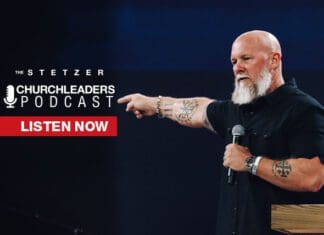On April 4th, the White House clarified that the Paycheck Protection Program (PPP), which allows small businesses to apply for federally-backed and forgivable loans, also applies to churches and other religious organizations. The program allocates $350 billion of the $2 trillion set aside in the CARES Act to be used for small businesses experiencing financial loss due to the coronavirus pandemic yet still attempting to pay their employees.
“Faith-based organizations are eligible to receive SBA loans regardless of whether they provide secular social services,” a statement clarifying the eligibility of churches applying for the loans from the Small Business Association reads.
Churches can start applying now (applications were available starting April 3rd) through June 30, 2020. Churches interested in applying will need to fill out the application and submit it to an SBA participating lender such as Wells Fargo, U.S. Bank, and Chase. However, the money available under these loans appears to be going quickly. For instance, on April 5, Wells Fargo CEO Charlie Scharf announced the bank would be limiting the loans it awards to nonprofits and small businesses with fewer than 50 employees due to the expected event that they will reach their lending capacity soon.
Politicians such as U.S. Treasury Secretary Steven Mnuchin, Senate Minority Leader Chuck Schumer, and Senate Majority Leader Mitch McConnell are already working on a plan for additional funding to keep the PPP going. While Speaker of the House Nancy Pelosi agrees more funding is necessary, she is pushing for more data to be collected on who is being served and underserved by the loans before more funding is given.
The loans can be used for paying employee wages, benefits, and retirement funds. The loans can also be used to cover church utility payments, mortgages or leases. Additionally, these loans may qualify for forgiveness. However, as a guide put together by the Ethics and Religious Liberties Commission (ERLC) points out, there are certain stipulations in place to ensure that the money used for these loans goes to employee salaries and that the church maintains its staff. For a good explanation on the loan forgiveness eligibility, check out the ERLC guide.
Who Is Eligible for the Paycheck Protection Program?
First of all, the question on many ministers’ minds is whether or not all churches are eligible for the loans. Churches and para-church organizations are eligible as long as they meet the requirements of 501(c)(3) status. Churches don’t necessarily have to be registered with the IRS this way, but they do need to meet those requirements. In other words, if you have not yet applied to be classified as a 501(c)(3) organization or you are operating under another organization’s tax exempt status, you can still apply for a loan.
Additionally, churches will need to ensure they have 500 or fewer employees, which is the benchmark that separates small businesses from larger ones. This could cause some problems for churches that are associated with a diocese as the number of employees in affiliated churches across a large city could potentially be greater than 500. More information on that stipulation and what qualifies as an affiliated organization can be found here.
Other questions on the minds of church leaders concern issues of religious liberty. For instance, will churches have to comply with things like employment nondiscrimination legislation if they accept a federal loan? The federal government is assuring churches that they can still operate unencumbered (for instance, employing the people they choose to employ, making certain requirements for membership, etc.):
Receipt of a loan through any SBA program does not (1) limit the authority of religious organizations to define the standards, responsibilities, and duties of membership; (2) limit the freedom of religious organizations to select individuals to perform work connected to that organization’s religious exercise; nor (3) constitute waiver of any rights under federal law, including rights protecting religious autonomy and exercise under the Religious Freedom Restoration Act of 1993 (RFRA), 42 U.S.C. § 2000b et seq., Section 702 of the Civil Rights Act of 1964, 42 U.S.C. § 2000e-1(a), or the First Amendment.
Simply put, a faith-based organization that receives a loan will retain its independence, autonomy, right of expression, religious character, and authority over its governance, and no faith-based organization will be excluded from receiving funding because leadership with, membership in, or employment by that organization is limited to persons who share its religious faith and practice.
However, churches are required to adhere to certain “nondiscrimination obligations” during the duration of the loan. These obligations require that churches that receive loans “may not discriminate on the basis of race, color, religion, sex, handicap, age, or national origin with regard to goods, services, or accommodations offered.” In other words, if a church runs a soup kitchen, they cannot refuse to serve a person of a different faith. Again, though, the document reiterates that these nondiscrimination obligations do not apply to the church’s employment policies. Put another way, churches that believe in a traditional view of marriage, for instance, would not be obligated to hire a minister in a same-sex marriage.
Churches are also not required to describe their religious beliefs when applying for the loan. For a full set of FAQs the SBA has answered, go here.
What About the Separation of Church and State?
Many pastors and church leaders have expressed concern over the federally-backed loans on the grounds of wanting to maintain separation of church and state. To this point, Russell Moore of the ERLC says that since the federal government is asking the public to put a hold on “normal” life (going to church, working for some people, etc.), the situation is similar to compensating churches for land involving an eminent domain case. “Almost no one would see such reimbursement as an endorsement of the views represented by that business or nonprofit, much less as a public-private partnership,” Moore writes.
Moore also addressed the concern that especially if the loans are forgivable, perhaps the federal government will feel entitled to exercise more control over a church’s operations. “We have no indication that such would be the case, and, were any future governing authority to seek retroactively to restrict the First Amendment on such grounds, I believe such a move would be successfully repudiated in court,” Moore writes in response.















